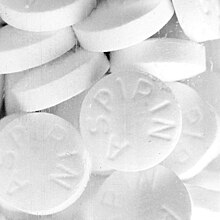
Back Dwelmmiddel Afrikaans Droge ALS መድኃኒት Amharic Sapaiyo AMI عقار (مادة كيميائية) Arabic Droga AST Bioloji aktiv maddə Azerbaijani داوا AZB Droga BCL Биологично активни вещества Bulgarian

A drug is any chemical substance that when consumed causes a change in an organism's physiology, including its psychology, if applicable.[1][2][vague] Drugs are typically distinguished from food and other substances that provide nutritional support. Consumption of drugs can be via inhalation, injection, smoking, ingestion, absorption via a patch on the skin, suppository, or dissolution under the tongue.
In pharmacology, a drug is a chemical substance, typically of known structure, which, when administered to a living organism, produces a biological effect.[3] A pharmaceutical drug, also called a medication or medicine, is a chemical substance used to treat, cure, prevent, or diagnose a disease or to promote well-being.[1] Traditionally drugs were obtained through extraction from medicinal plants, but more recently also by organic synthesis.[4] Pharmaceutical drugs may be used for a limited duration, or on a regular basis for chronic disorders.[1]
Pharmaceutical drugs are often classified into drug classes—groups of related drugs that have similar chemical structures, the same mechanism of action (binding to the same biological target), a related mode of action, and that are used to treat the same disease.[5][6] The Anatomical Therapeutic Chemical Classification System (ATC), the most widely used drug classification system, assigns drugs a unique ATC code, which is an alphanumeric code that assigns it to specific drug classes within the ATC system. Another major classification system is the Biopharmaceutics Classification System. This classifies drugs according to their solubility and permeability or absorption properties.[7]
Psychoactive drugs are substances that affect the function of the central nervous system, altering perception, mood or consciousness.[8] These drugs are divided into different groups like: stimulants, depressants, antidepressants, anxiolytics, antipsychotics, and hallucinogens. These psychoactive drugs have been proven useful in treating wide range of medical conditions including mental disorders around the world. The most widely used drugs in the world include caffeine, nicotine and alcohol,[9] which are also considered recreational drugs, since they are used for pleasure rather than medicinal purposes.[10] All drugs can have potential side effects.[11] Abuse of several psychoactive drugs can cause addiction and/or physical dependence.[12] Excessive use of stimulants can promote stimulant psychosis. Many recreational drugs are illicit and international treaties such as the Single Convention on Narcotic Drugs exist for the purpose of their prohibition.
- ^ a b c "Drug". Drug Definition & Meaning. The American Heritage Science Dictionary. Houghton Mifflin Company. Archived from the original on 14 September 2007. Retrieved 20 September 2007 – via dictionary.com.
- ^ "Drug Definition". Stedman's Medical Dictionary. Archived from the original on 2014-05-02. Retrieved 2014-05-01 – via Drugs.com.
- ^ H.P., Rang; M.M, Dale; J.M., Ritter; R.J., Flower; G., Henderson (2011). "What is Pharmacology". Rang & Dale's pharmacology (7 ed.). Edinburgh: Churchill Livingstone. p. 1. ISBN 978-0-7020-3471-8.
a drug can be defined as a chemical substance of known structure, other than a nutrient of an essential dietary ingredient, which, when administered to a living organism, produces a biological effect
- ^ Atanasov AG, Waltenberger B, Pferschy-Wenzig EM, Linder T, Wawrosch C, Uhrin P, Temml V, Wang L, Schwaiger S, Heiss EH, Rollinger JM, Schuster D, Breuss JM, Bochkov V, Mihovilovic MD, Kopp B, Bauer R, Dirsch VM, Stuppner H (December 2015). "Discovery and resupply of pharmacologically active plant-derived natural products: A review". Biotechnol Adv. 33 (8): 1582–614. doi:10.1016/j.biotechadv.2015.08.001. PMC 4748402. PMID 26281720.
- ^ Mahoney A, Evans J (6 November 2008). "Comparing drug classification systems". AMIA Annual Symposium Proceedings: 1039. PMID 18999016.
- ^ World Health Organization (2003). Introduction to drug utilization research (PDF). Geneva: World Health Organization. p. 33. ISBN 978-92-4-156234-8. Archived from the original (PDF) on 2016-01-22.
- ^ Bergström, CA; Andersson, SB; Fagerberg, JH; Ragnarsson, G; Lindahl, A (16 June 2014). "Is the full potential of the biopharmaceutics classification system reached?". European Journal of Pharmaceutical Sciences. 57: 224–31. doi:10.1016/j.ejps.2013.09.010. PMID 24075971.
- ^ "An overview of alcohol and other drug issues". Archived from the original on 2015-03-28. Retrieved 2015-03-16.
- ^ Crocq MA (June 2003). "Alcohol, nicotine, caffeine, and mental disorders". Dialogues Clin. Neurosci. 5 (2): 175–185. doi:10.31887/DCNS.2003.5.2/macrocq. PMC 3181622. PMID 22033899.
- ^ "Recreational Drug". The Free Dictionary. Archived from the original on 15 September 2015. Retrieved 16 March 2015.
- ^ "MHRA Side Effects of Medicines." Archived 2014-05-02 at the Wayback Machine MHRA Side Effects of Medicines,
- ^ Fox, Thomas Peter; Oliver, Govind; Ellis, Sophie Marie (2013). "The Destructive Capacity of Drug Abuse: An Overview Exploring the Harmful Potential of Drug Abuse Both to the Individual and to Society". ISRN Addiction. 2013: 450348. doi:10.1155/2013/450348. PMC 4392977. PMID 25938116.